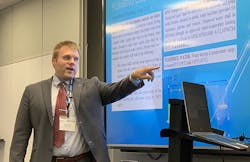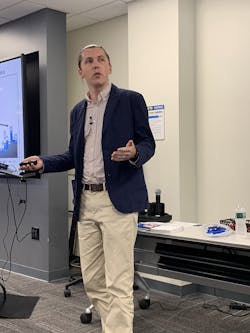NORTH ANDOVER, MA — “They always put the stop sign in at the dangerous intersection after the accident, right?” said an editorial colleague in response to a side conversation regarding a Legionella presentation at the 2nd Healthcare Symposium hosted by Watts Water Technologies. The symposium featured four high-level executives whose expertise centered around a comprehensive approach to mitigating opportunistic waterborne pathogens, especially Legionella.
When it comes to Legionella assessment, for example, there is continued debate throughout the industry on cost justification vs. actual risk. What is the cost of not putting a water safety plan in place? Injury, death, lawsuits, negative publicity, etc. Is this not enough to be acting now toward a more proactive approach to mitigation? Although Legionella can’t be “eradicated” entirely in plumbing systems, implementing safeguards and following through with proper processes to keep a healthcare facility relatively “safe” from opportunistic pathogens—while it does incur a cost—should be the proper approach, and it is fiscally responsible.
The proactive vs. reactive conversation stemmed as a response to the presentation by Shatha Salah, Environmental Manager, UAB Medicine, the first of four speakers at the symposium. Following a Legionella outbreak at the University Hospital, Salah is now responsible for directing and managing the UAB Medicine Water Safety Plan and serves as a member on the UAB Medicine water safety team. “It’s important to create a team for a water safety plan, which includes plumbers who are the front-line soldiers in the fight against Legionella,” says Salah. “The plumber’s role is important in protecting patients from waterborne illnesses.”
Through a combination of a supplemental water treatment system and point-of-use filters, UAB gained control of Legionella growth in the building and began developing a comprehensive water safety plan, engaging team members that can take action and influence process change to conduct risk assessments to help mitigate the growth and distribution of waterborne pathogens.
Dr. William Rhoads, EIT, PhD, postdoctoral researcher, Virginia Tech, focused on the importance of proper assessment of engineering controls and understanding water quality with his “Controlling Opportunistic Pathogen Growth in Building Plumbing” presentation.
Rhoads suggests some Engineering Control Strategies:
• Control Water Age—flow conditions
• Limit Nutrients
• Pipe Material Selection
• Secondary Residual Type and Dose—including in-building treatment
• Water Heater Set Point— including thermal shock
• Probiotic/Prebiotic
• Upgrade Water Mains
• System Design—hot water recirc, piping strategy
Why the increased incidence of Legionella? Rhoads suggests a few reasons: improved detection and diagnosis; people are spending more time indoors; changing demographics and immunodeficiency status; and the unintended consequences of more sustainable buildings and cities. “Sustainability in buildings may increase water age—the Distribution System Water Age + Precise Plumbing System Water Age—which can lead to more opportunistic pathogens,” says Rhoads.
Piggybacking Rhoads’ points, Aaron Bock, PE, CPD, Plumbing and Fire Protection Discipline Leader, Cannon Design, suggests that some challenges include building codes, standards and guideline; equipment and fixtures; and building piping and design. Items such as low flow and seldomly used fixtures can lead to stagnant water, which encourages bacterial growth, says Bock. Programmable sensor faucets, for instance, should be chosen carefully and limited to high-traffic areas. Other concerns include water system size and age, building location, equipment and appliances and uncirculated piping can all lead to problems.
Bock’s solutions include:
• Plumbing System Design
Selection of Fixtures & Materials
- Laminar Flow or Open Faucet Spouts
- Placement of Fixtures
- Sanitizable Fixtures & Piping Materials
- Hands-Free Faucet Operation
- Sensors in Public Areas Only
Temperature & Flow Maintenance
- Limiting uncirculated water piping accomplishes both
- Recognize devices/piping that create stagnation
- Don’t ignore cold water systems
- Isolation of System Sections
• Chemical/Ion Injection
- Chlorine
- Chlorine Dioxide
- Monochloromine
- Copper-Silver Ionization
• Supplemental Measures
- Elevated Water Temperatures
- Ultrafiltration—Total Building, Hot Water, Point-of-Use
Moreover, Bock suggests implementing Design, Construction and Occupancy Phases, which include fixture selection and future provisions during the design, flushing and disinfecting water lines during construction, and water management plans, monitoring control points and maintenance during occupancy. “It’s important to education building owners during the design phase,” says Bock.
Frank Sidari, Technical Director, Special Pathogens Laboratory, an encore speaker from the Watts’ inaugural Healthcare Symposium, placed continued emphasis on the importance of a water management plan. Sidari focused on a closer inspection on how engineers, facility managers and infection control can work to manage building water systems to reduce the risk associated with opportunistic waterborne pathogens and coordinate efforts with their water safety and management program. Interestingly, he cited a National Academies of Sciences, Engineering, and Medicine (NASEM) report that states, “Stronger policies are needed to protect the public against Legionnaires’ Disease.”
Perhaps building codes and standards can take a more focused look in mandating more stringent building compliance when it comes to mitigation and a tangible action plan. In the meantime the bottom line is this: it is better to be proactive than reactive when considering water safety and pathogen mitigation in healthcare facilities.


